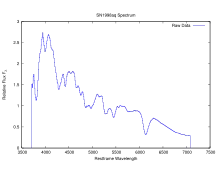SN 1998aq
SN 1998aq is a nearby supernova located in the intermediate spiral galaxy NGC 3982, offset 18″ west and 7″ of the galactic nucleus. It was discovered April 13, 1998 by amateur astronomer Mark Armstrong[2] and was confirmed by fellow British amateur Ron Arbour; both members of the U.K. Supernova/Nova Patrol.[4] The event was not visible on a prior check by Armstrong made April 7.[5] It reached peak brightness on April 27, and 15 days later had declined by 1.14 magnitudes in the B (blue) band.[4]

| Event type | Supernova |
|---|---|
| Type Ia[1] | |
| Date | April 13, 1998[2] |
| Constellation | Ursa Major |
| Right ascension | 11h 56m 25.87s[1] |
| Declination | +55° 07′ 43.2″[1] |
| Distance | 70.38 ± 0.23 Mly (21.58 ± 0.07 Mpc)[3] |
| Redshift | 0.0004, 0.0003, 0.002 |
| Host | NGC 3982[1] |
| Colour (B-V) | −0.18[4] (peak) |
| Peak apparent magnitude | 12.36[1] |
Spectroscopic observations determined this was a Type Ia supernova event, and it became one of the best-studied supernova of its type, at least in the visual band.[4] An absorption feature of singly-ionized carbon was (probably) detected nine days before maximum, an indication of unburned ash left over from the original carbon-oxygen core of the progenitor white dwarf.[7] Brightness calibration using Cepheid variables in NGC 3982 gives a peak absolute magnitude estimate of at least −19.47±0.15 (assuming no extinction in the host galaxy).[8]
References
- Barbon, R.; et al. (2008). Asiago Supernova Catalogue. Bibcode:2008yCat....1.2024B.
{{cite book}}:|work=ignored (help) - Hurst, G. M.; et al. (April 1998). Green, D. W. E. (ed.). "Supernova 1998aq in NGC 3982". IAU Circular. 6875: 1. Bibcode:1998IAUC.6875....1H.
- Tully, R. Brent; et al. (October 2013). "Cosmicflows-2: The Data". The Astronomical Journal. 146 (4): 25. arXiv:1307.7213. Bibcode:2013AJ....146...86T. doi:10.1088/0004-6256/146/4/86. S2CID 118494842. 86.
- Branch, David; et al. (September 2003). "Optical Spectra of the Type Ia Supernova 1998aq". The Astronomical Journal. 126 (3): 1489–1498. arXiv:astro-ph/0305321. Bibcode:2003AJ....126.1489B. doi:10.1086/377016. S2CID 14239562.
- Hewitt, N. (April 2000). "The first seven UK supernova discoveries". Journal of the British Astronomical Association. 110 (2): 65–79. Bibcode:2000JBAA..110...65H.
- Matheson, T.; et al. (2008). "Optical Spectroscopy of Type Ia Supernovae". Astronomical Journal. 135 (4): 1598–1615. arXiv:0803.1705. Bibcode:2008AJ....135.1598M. doi:10.1088/0004-6256/135/4/1598. S2CID 33156459.
- Parrent, Jerod T.; et al. (May 2011). "A Study of Carbon Features in Type Ia Supernova Spectra". The Astrophysical Journal. 732 (1): 15. arXiv:1103.1671. Bibcode:2011ApJ...732...30P. doi:10.1088/0004-637X/732/1/30. S2CID 119199279. 30.
- Saha, A.; et al. (November 2001). "Cepheid Calibration of the Peak Brightness of Type Ia Supernovae. XI. SN 1998aq in NGC 3982". The Astrophysical Journal. 562 (1): 314–336. arXiv:astro-ph/0107391. Bibcode:2001ApJ...562..314S. doi:10.1086/323529. S2CID 119364520.
External links
- Light curves and spectra Archived 2017-11-14 at the Wayback Machine on the Open Supernova Catalog
- SN 1998aq in NGC 3982